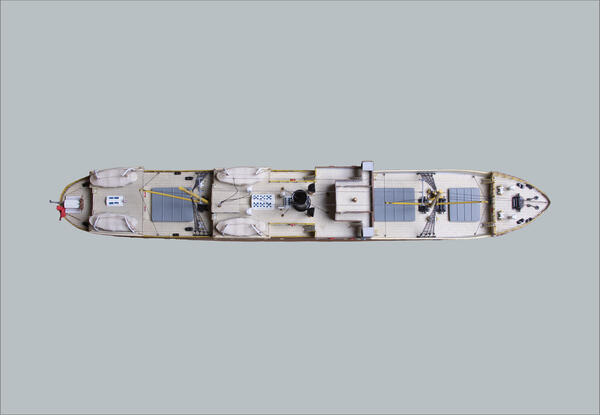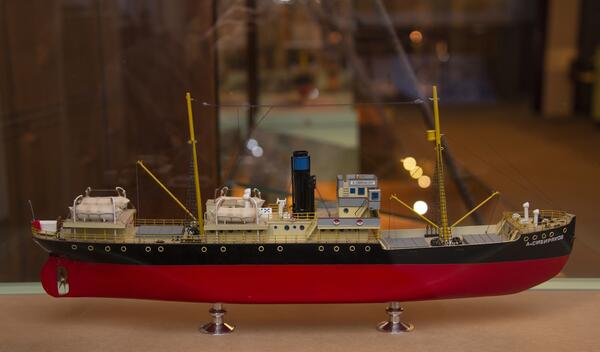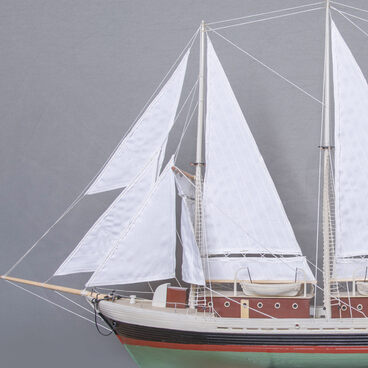The icebreaking steamer Bellaventure, commissioned by a British company of the same name, was laid down in 1908 and used as a seal-hunting ship.
In 1915 she was purchased by the Russian Imperial Ministry of Trade and Industry and renamed Alexander Sibiryakov. It began making winter voyages on the White Sea.
The first heroic journey of the Sibiryakov took place in 1932. The research expedition led by Otto Schmidt was the first in history to traverse the Northern Sea Route in a single navigation season without a winter stop. The ship was captained Vladimir Ivanovich Voronin.
In the summer of 1941, the Sibiryakov was fitted with two 76-mm guns at the stern, two 45-mm guns at the foredeck, and two 20-mm anti-aircraft “Erlikon” guns. Under the command of Lieutenant Anatoly Alekseevich Kacharava the vessel became part of the White Sea War Fleet.
Caravans carrying food and raw materials for defense plants passed along the Northern Sea Route. Hitler’s troops tried to gain control of this waterway.
In 1942, the Germans undertook Operation “Wunderland”. The heavy cruiser Admiral Scheer left the Norwegian port of Narvik in order to enter Vilkitsky Strait suddenly and intercept the Arkhangelsk and Petropavlovsk vessels. At the same time, the Sibiryakov was heading east from Dikson to replace the winterers at the polar stations of Severnaya Zemlya. On August 25, a warship flying the American flag was spotted from the Sibiryakov near Belukha Island. The “Americans” requested information about the location of the caravans and the ice conditions. Having suspected something wrong Kacharava ordered to go to Belukha, and the radio operator Anatoly Sharshavin broadcasted information about the unknown cruiser. Understanding that the maneuver was unsuccessful, the Germans started firing at the Sibiryakov. The battle lasted less than an hour, the forces were unequal. Heavily wounded Kacharava ordered to abandon the ship and sink her. Senior engineer Nikolay Grigoryevich Bochurko and deputy political officer Zelik Abramovich Elimelakh opened the flood valves and never went up. Many of the passengers and crew perished from burns and shells while still on board, others were shot dead in the water. The captain, the meteorologist, the engineer, and about 20 other persons were taken prisoner. The Nazis never managed to obtain valuable information, and by engaging in combat they finally exposed themselves. The German plan failed.
The legendary Alexander Sibiryakov went underwater without lowering her flag.
The presented model was commissioned by the Taimyr Local History Museum to open a new exhibition.
In 1915 she was purchased by the Russian Imperial Ministry of Trade and Industry and renamed Alexander Sibiryakov. It began making winter voyages on the White Sea.
The first heroic journey of the Sibiryakov took place in 1932. The research expedition led by Otto Schmidt was the first in history to traverse the Northern Sea Route in a single navigation season without a winter stop. The ship was captained Vladimir Ivanovich Voronin.
In the summer of 1941, the Sibiryakov was fitted with two 76-mm guns at the stern, two 45-mm guns at the foredeck, and two 20-mm anti-aircraft “Erlikon” guns. Under the command of Lieutenant Anatoly Alekseevich Kacharava the vessel became part of the White Sea War Fleet.
Caravans carrying food and raw materials for defense plants passed along the Northern Sea Route. Hitler’s troops tried to gain control of this waterway.
In 1942, the Germans undertook Operation “Wunderland”. The heavy cruiser Admiral Scheer left the Norwegian port of Narvik in order to enter Vilkitsky Strait suddenly and intercept the Arkhangelsk and Petropavlovsk vessels. At the same time, the Sibiryakov was heading east from Dikson to replace the winterers at the polar stations of Severnaya Zemlya. On August 25, a warship flying the American flag was spotted from the Sibiryakov near Belukha Island. The “Americans” requested information about the location of the caravans and the ice conditions. Having suspected something wrong Kacharava ordered to go to Belukha, and the radio operator Anatoly Sharshavin broadcasted information about the unknown cruiser. Understanding that the maneuver was unsuccessful, the Germans started firing at the Sibiryakov. The battle lasted less than an hour, the forces were unequal. Heavily wounded Kacharava ordered to abandon the ship and sink her. Senior engineer Nikolay Grigoryevich Bochurko and deputy political officer Zelik Abramovich Elimelakh opened the flood valves and never went up. Many of the passengers and crew perished from burns and shells while still on board, others were shot dead in the water. The captain, the meteorologist, the engineer, and about 20 other persons were taken prisoner. The Nazis never managed to obtain valuable information, and by engaging in combat they finally exposed themselves. The German plan failed.
The legendary Alexander Sibiryakov went underwater without lowering her flag.
The presented model was commissioned by the Taimyr Local History Museum to open a new exhibition.




